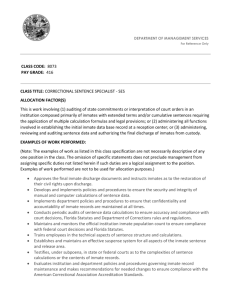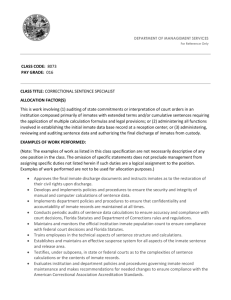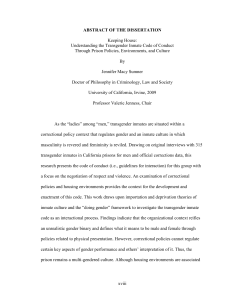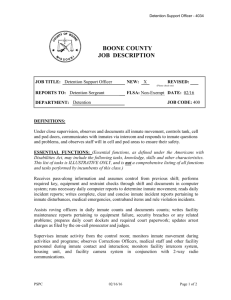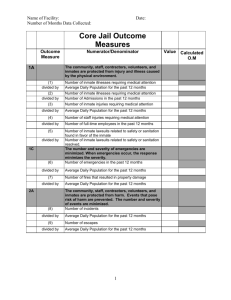Characteristics of Total Institutions by Erving Goffman, In this essay
advertisement
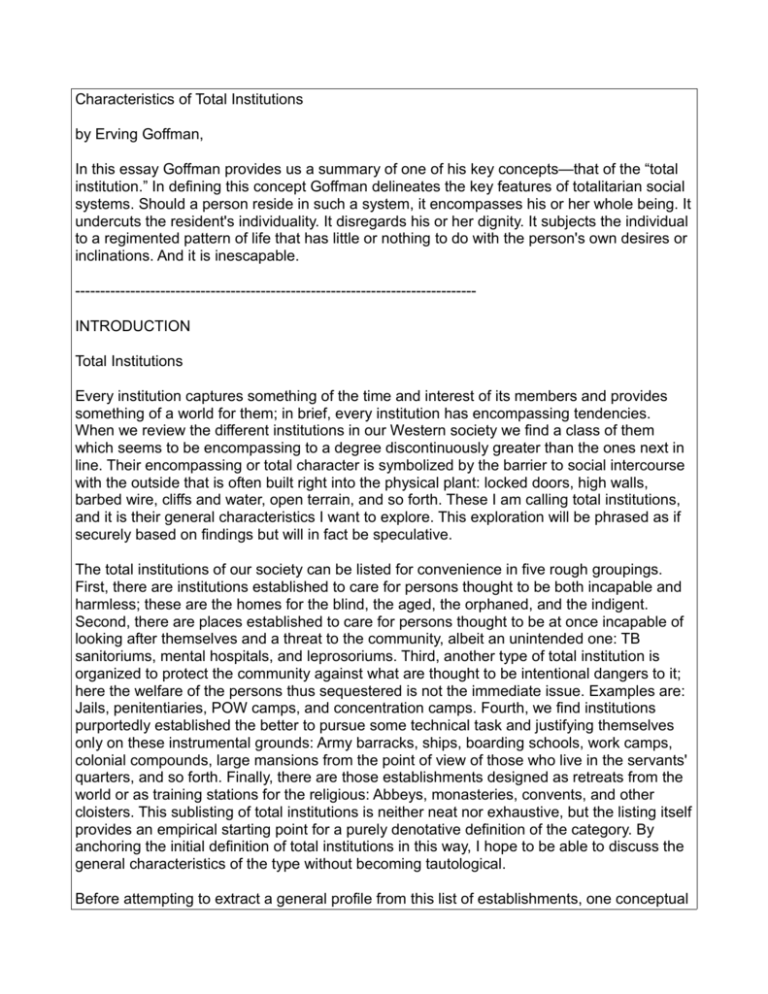
Characteristics of Total Institutions by Erving Goffman, In this essay Goffman provides us a summary of one of his key concepts—that of the “total institution.” In defining this concept Goffman delineates the key features of totalitarian social systems. Should a person reside in such a system, it encompasses his or her whole being. It undercuts the resident's individuality. It disregards his or her dignity. It subjects the individual to a regimented pattern of life that has little or nothing to do with the person's own desires or inclinations. And it is inescapable. -------------------------------------------------------------------------------INTRODUCTION Total Institutions Every institution captures something of the time and interest of its members and provides something of a world for them; in brief, every institution has encompassing tendencies. When we review the different institutions in our Western society we find a class of them which seems to be encompassing to a degree discontinuously greater than the ones next in line. Their encompassing or total character is symbolized by the barrier to social intercourse with the outside that is often built right into the physical plant: locked doors, high walls, barbed wire, cliffs and water, open terrain, and so forth. These I am calling total institutions, and it is their general characteristics I want to explore. This exploration will be phrased as if securely based on findings but will in fact be speculative. The total institutions of our society can be listed for convenience in five rough groupings. First, there are institutions established to care for persons thought to be both incapable and harmless; these are the homes for the blind, the aged, the orphaned, and the indigent. Second, there are places established to care for persons thought to be at once incapable of looking after themselves and a threat to the community, albeit an unintended one: TB sanitoriums, mental hospitals, and leprosoriums. Third, another type of total institution is organized to protect the community against what are thought to be intentional dangers to it; here the welfare of the persons thus sequestered is not the immediate issue. Examples are: Jails, penitentiaries, POW camps, and concentration camps. Fourth, we find institutions purportedly established the better to pursue some technical task and justifying themselves only on these instrumental grounds: Army barracks, ships, boarding schools, work camps, colonial compounds, large mansions from the point of view of those who live in the servants' quarters, and so forth. Finally, there are those establishments designed as retreats from the world or as training stations for the religious: Abbeys, monasteries, convents, and other cloisters. This sublisting of total institutions is neither neat nor exhaustive, but the listing itself provides an empirical starting point for a purely denotative definition of the category. By anchoring the initial definition of total institutions in this way, I hope to be able to discuss the general characteristics of the type without becoming tautological. Before attempting to extract a general profile from this list of establishments, one conceptual peculiarity must be mentioned. ,None of the elements I will extract seems entirely exclusive to total institutions, and none seems shared by every one of them. What is shared and unique about total institutions is that each exhibits many items in this family of attributes to an intense degree. In speaking of "common characteristics," then, I will be using this phrase in a weakened, but I think logically defensible, way. Totalistic Features A basic social arrangement in modem society is that we tend to sleep, play and work in different places, in each case with a different set of coparticipants, under a different authority, and without an overall rational plan. The central feature of total institutions can be described as a breakdown of the kinds of barriers ordinarily separating these three spheres of life. First, all aspects of life are conducted in the same place and under the same single authority. Second, each phase of the member's daily activity will be carried out in the immediate company of a large batch of others, all of whom are treated alike and required to do the same thing together. Third, all phases of the day's activities are tightly scheduled, with one activity leading at a prearranged time into the next, the whole circle of activities being imposed from above through a system of explicit formal rulings and a body of officials. Finally, the contents of the various enforced activities are brought together as parts of a single overall rational plan purportedly designed to fulfill the official aims of the institution. Individually, these totalistic features are found, of course, in places other than total institutions. Increasingly, for example, our large commercial, industrial and educational establishments provide cafeterias, minor services and off-hour recreation for their members. But while this is a tendency in the direction of total institutions, these extended facilities remain voluntary in many particulars of their use, and special care is taken to see that the ordinary line of authority does not extend to these situations. Similarly, housewives or farm families can find all their major spheres of life within the same fenced-in area, but these persons are not collectively regimented and do not march through the day's steps in the immediate company of a batch of similar others. The handling of many human needs by the bureaucratic organization of whole blocks of people-whether or not this is a necessary or effective means of social organization in the circumstances-can be taken, then, as the key fact of total institutions. From this, certain important implications can be drawn. Given the fact that blocks of people are caused to move in time, it becomes possible to use a relatively small number of supervisory personnel where the central relationship is not guidance or periodic checking, as in many employer-employee relations, but rather surveillance-a seeing to it that everyone does what he has been clearly told is required of him, and this under conditions where one person's infraction is likely to stand out in relief against the visible, constantly examined, compliance of the others. . . . In total institutions. . . there is a basic split between a large class of individuals who live in and who have restricted contact with the world outside the walls, conveniently called inmates, and the small class that supervises them, conveniently called staff, who often operate on an 8-hour day and are socially integrated into the outside world. Each grouping tends to conceive of members of the other in terms of narrow hostile stereotypes, staff often seeing inmates as bitter, secretive and untrustworthy, while inmates often see staff as condescending, highhanded and mean. Staff tends to feel superior and righteous; inmates tend, in some ways at least, to feel inferior, weak, blameworthy and guilty. Social mobility between the two strata is grossly restricted; social distance is typically great and often formally pre- scribed; even talk across the boundaries may be conducted in a special tone of voice. These restrictions on contact presumably help to maintain the antagonistic stereotypes. In any case, two different social and cultural worlds develop, tending to jog along beside each other, with points of official contact but little mutual penetration. It is important to add that the institutional plan and name comes to be identified by both staff and inmates as somehow belonging to staff, so that when' either grouping refers to the views or interests of ' 'the institution," by implication they are referring to the views and concerns of the staff. The staff-inmate split is one major implication of the central features of total institutions; a second one pertains to work. In the ordinary arrangements of living in our society, the authority of the work- place stops with the worker's receipt of a money payment; the spending of this in a domestic and recreational setting is at the discretion of the worker and is the mechanism through which the authority of the workplace is kept within strict bounds. However, to say that inmates in total institutions have their full day scheduled for them is to say that some version of all basic needs will have to be planned for, too. In other words, total institutions take over "responsibility" for the in- mate and must guarantee to have everything that is defined as essential “layed on." It follows, then, that whatever incentive is given for work, this will not have the structural significance it has on the out- side. Different attitudes and incentives regarding this central feature of our life will have to prevail. Here, then, is one basic adjustment required of those who work in total institutions and of those who must induce these people to work. In some cases, no work or little is required, and inmates, untrained often in leisurely ways of life, suffer extremes of boredom. In other cases, some work is required but is carried on at an extremely slow pace, being geared into a system of minor, often ceremonial payments, as in the case of weekly tobacco ration and annual Christmas presents, which cause some mental patients to stay on their job. In some total institutions, such as logging camps and merchant ships, something of the usual relation to the world that money can buy is obtained through the practice of" forced saving"; all needs are organized by the institution, and payment is given only after a work season is over and the men leave the premises. And in some total institutions, of course, more than a full day's work is required and is induced not by reward, but by threat of dire punishment. In all such cases, the work-oriented individual may tend to become somewhat demoralized by the system. In addition to the fact that total institutions are incompatible with the basic work-payment structure of our society, it must be seen that these establishments are also incompatible with another crucial element of our society, the family. The family is sometimes contrasted to solitary living, but in fact the more pertinent contrast to family life might be with batch [block] living. For it seems that those who eat and sleep at work, with a group of fellow workers, can hardly sustain a meaningful domestic existence. Correspondingly, the extent to which a staff retains its integration in the outside community and escapes the encompassing tendencies of total institutions is often linked up with the maintenance of a family off the grounds. Whether a particular total institution acts as a good or bad force in civil society, force it may well have, and this will depend on the suppression of a whole circle of actual or potential households. Conversely, the formation of households provides a structural guarantee that total institutions will not arise. The incompatibility between' these two forms of social organization should tell us, then, something about the wider social functions of them both. Total institutions, then, are social hybrids, part residential community, part formal organization, and therein lies their special sociological interest. There are other reasons, alas, for being interested in them, too. These establishments are the forcing houses for changing persons in our society. Each is a natural experiment, typically harsh, on what can be done to the self. Having suggested some of the key features of total institutions, we can move on now to consider them from the special perspectives that seem natural to take. I will consider the inmate world, then the staff world, and then something about contacts between the two. THE INMATE WORLD Mortification Processes It is characteristic of inmates that they come to the institution as members, already fullfledged, of a home world, that is, a way of life and a round of activities taken for granted up to the point of admission to the institution. It is useful to look at this culture that the recruit brings with him to the institution's door-his presenting culture, to modify a psychiatric phrasein terms especially designed to highlight what it is the total institution will do to him. Whatever the stability of his personal organization, we can assume it was part of a wider sup- porting framework lodged in his current social environment, a round of experience that somewhat confirms a conception of self that is somewhat acceptable to him and a set of defensive maneuvers exercisable at his own discretion as a means of coping with conflicts, discreditings and failures. Now it appears that total institutions do not substitute their own unique culture for something already formed. We do not deal with acculturation or assimilation but with something more restricted than these. In a sense, total institutions do not look for cultural victory. They effectively create and sustain a particular kind of tension between the home world and the institutional world and use this persistent tension as strategic leverage in the management of men. The full meaning for the inmate of being "in" or "on the inside" does not exist apart from the special meaning to him of "getting out" or "getting on the outside." The recruit comes into the institution with a self and with attachments to supports which had allowed this self to survive. Upon entrance, he is immediately stripped of his wonted supports, and his self is systematically, if often unintentionally, mortified. In the accurate language of some of our oldest total institutions, he is led into a series of abasements, degradations, humiliations, and profanations of self. He begins, in other words, some radical shifts in his moral career, a career laying out the progressive changes that occur in the beliefs that he has concerning himself and significant others. The stripping processes through which mortification of the self occurs are fairly standard in our total institutions. Personal identity equipment is removed, as well as other possessions with which the inmate may have identified himself, there typically being a system of nonaccessible storage from which the inmate can only reobtain his effects should he leave the institution. As a substitute for what has been taken away, institutional issue is provided, but this will be the same for large categories of inmates and will be regularly repossessed by the institution. In brief, standardized defacement will occur. . . . Family, occupational, and educational career lines are chopped off, and a stigmatized status is submitted. Sources of fantasy materials which had meant momentary releases from stress in the home world are denied. Areas of autonomous decision are eliminated through the process of collective scheduling of daily activity. Many channels of communication with the outside are restricted or closed off completely. Verbal discreditings occur in many forms as a matter of course. Expressive signs of respect for the staff are coercively and continuously demanded. And the effect of each of these conditions is multiplied by having to witness the mortification of one's fellow inmates. . . . In the background of the sociological stripping process, we find a characteristic authority system with three distinctive elements, each basic to total institutions. First, to a degree, authority is of the echelon kind. Any member of the staff class has certain rights to discipline any member of the inmate class. . . . In our society, the adult himself, however, is typically under the authority of a single immediate superior in connection with his work or under authority of one spouse in connection with domestic duties. The only echelon authority he must face-the police- typically are neither constantly nor relevantly present, except perhaps in the case of traffic-law enforcement. Second, the authority of corrective sanctions is directed to a great multitude of items of conduct of the kind that are constantly occurring and constantly coming up for judgment; in brief, authority is directed to matters of dress, deportment, social intercourse, manners and the like. . ... The third feature of authority in total institutions is that misbehaviors in one sphere of life are held against one's standing in other spheres. Thus, an individual who fails to participate with proper enthusiasm in sports may be brought to the attention of the person who determines where he will sleep and what kind of work task will be accorded to him. When we combine these three aspects of authority in total institutions, we see that the inmate cannot easily escape from the press of judgmental officials and from the enveloping tissue of constraint. The system of authority undermines the basis for control that adults in our society expect to exert over their interpersonal environment and may produce the terror of feeling that one is being radically demoted in the age-grading system. On the outside, rules are sufficiently lax and the individual sufficiently agreeable to required self-discipline to insure that others will rarely have cause for pouncing on him. He need not constantly look over his shoulder to see if criticism and other sanctions are coming. On the inside, however, rulings are abundant, novel, and closely enforced so that, quite characteristically, inmates live with chronic anxiety about breaking the rules and chronic worry about the consequences of breaking them. The desire to "stay out of trouble" in a total institution is likely to require persistent conscious effort and may lead the inmate to abjure certain levels of sociability with his fellows in order to avoid the incidents that may occur in these circumstances. It should be noted finally that the mortifications to be suffered by the inmate may be purposely brought home to him in an exaggerated way during the first few days after entrance, in a form of initiation that has been called the welcome. Both staff and fellow inmates may go out of their way to give the neophyte a clear notion of where he stands. As part of this rite de passage, he may find himself called by a term such as "fish," "swab," etc., through which older inmates tell him that he is not only merely an inmate but that even within this lowly group he has a low status. Privilege System While the process of mortification is in progress, the inmate begins to receive formal and informal instruction in what will here be called the privilege system. Insofar as the inmate's self has been unsettled a little by the stripping action of the institution, it is largely around this framework that pressures are exerted, making for a reorganization of self. Three basic elements of the system may be mentioned. First, there are the house rules, a relatively explicit and formal set of prescriptions and proscriptions which layout the main requirements of inmate conduct. These regulations spell out the austere round of life in which the inmate will operate. Thus, the admission procedures through which the recruit is initially stripped of his self-supporting context can be seen as the institution's way of getting him in the position to start living by the house rules. Second, against the stark background, a small number of clearly defined rewards or privileges are held out in exchange for obedience to staff in action and spirit. It is important to see that these potential gratifications are not unique to the institution but rather are ones carved out of the flow of support that the inmate previously had quite taken for granted. On the outside, for example, the inmate was likely to be able to unthinkingly exercise autonomy by deciding how much sugar and milk he wanted in his coffee, if any, or when to light up a cigarette; on the inside, this right may become quite problematic and a matter of a great deal of conscious concern. Held up to the inmate as possibilities, these few recapturings seem to have a reintegrative effect, re-establishing relationships with the whole lost world and assuaging withdrawal symptoms from it and from one's lost self. The inmate's run of attention, then, especially at first, comes to be fixated on these supplies and obsessed with them. In the most fanatic way, he can spend the day in devoted thoughts concerning the possibility of acquiring these gratifications or the approach of the hour at which they are scheduled to be granted. The building of a world around these minor privileges is perhaps the most important feature of inmate culture and yet is something that cannot easily be appreciated by an outsider, even one who has lived through the experience him- self. This situation sometimes leads to generous sharing and almost always to a willingness to beg for things such as cigarettes, candy and newspapers. It will be understandable, then, that a constant feature of inmate discussion is the release binge fantasy, namely, recitals of what one will do during leave or upon release from the institution. House rules and privileges provide the functional requirements of the third element in the privilege system: punishments. These are designated as the consequence of breaking the rules. One set of these punishments consists of the temporary or permanent withdrawal of privileges or abrogation of the right to try to earn them. In general, the punishments meted out in total institutions are of an order more severe than anything encountered by the inmate in his home world. An institutional arrangement which causes a small number of easily controlled privileges to have a massive significance is the same arrangement which lends a terrible significance to their withdrawal. There are some special features of the privilege system which should be noted. First, punishments and privileges are themselves modes of organization peculiar to total institutions. . . . And privileges, it should be emphasized; are not the same as prerequisites, indulgences or values, but merely the absence of deprivations one ordinarily expects one would not have to sustain. The very notions, then, of punishments and privileges are not ones that are cut from civilian cloth. Second, it is important to see that the question of release from the total institution is elaborated into the privilege system. Some acts will become known as ones that mean an increase or no decrease in length of stay, while others become known as means for lessening the sentence. Third, we should also note that punishments and privileges come to be geared into a residential work system. Places to work and places to sleep become clearly defined as places where certain kinds and levels of privilege obtain, and inmates are shifted very rapidly and visibly from one place to another as the mechanisms for giving them the punishment or privilege their cooperativeness has warranted. The inmates are moved, the system is not. . . . Immediately associated with the privilege system we find some standard social processes important in the life of total institutions. We find that an institutional lingo develops through which inmates express the events that are crucial in their particular world. Staff too, especially its lower levels, will know this language, using it when talking to inmates, while reverting to more standardized speech when talking to superiors and outsiders. Related to this special argot, in- mates will possess knowledge of the various ranks and officials, an accumulation of lore about the establishment, and some comparative information about life in other similar total institutions. Also found among staff and inmates will be a clear awareness of the phenomenon of messing up, so called in mental hospitals, prisons, and barracks. This involves a complex process of engaging in forbidden activity, getting caught doing so, and receiving something like the full punishment accorded this. An alteration in privilege status is usually implied and is categorized by a phrase such as "getting busted." Typical infractions which can eventuate in messing up are: fights, drunkenness, attempted suicide, failure at examinations, gambling, insubordination, homosexuality, improper taking of leave, and participation in collective riots. While these punished infractions are typically ascribed to the offender's cussedness, villainy, or "sickness," they do in fact constitute a vocabulary of institutionalized actions, limited in such a way that the same messing up may occur for quite different reasons. Informally, inmates and staff may understand, for example, that a given messing up is a way for inmates to show resentment against a current situation felt to be unjust in terms of the informal agreements between staff and inmates, or a way of postponing release without having to admit to one's fellow inmates that one really does not want to go. In total institutions there will also be a system of what might be called secondary adjustments, namely, technics which do not directly challenge staff management but which allow inmates to obtain disallowed satisfactions or allowed ones by disallowed means. These practices are variously referred to as: the angles, knowing the ropes, conniving, gimmicks, deals, ins, etc. Such adaptations apparently reach their finest flower in prisons, but of course other total institutions are overrun with them too. It seems apparent that an important aspect of secondary adjustments is that they provide the inmate with some evidence that he is still, as it were, his own man and still has some protective distance, under his own control, between himself and the institution. . . . The occurrence of secondary adjustments correctly allows us to assume that the inmate group will have some kind of a code and some means of informal social control evolved to prevent one inmate from informing staff about the secondary adjustments of another. On the same grounds we can expect that one dimension of social typing among inmates will turn upon this question of security, leading to persons defined as "squealers," "finks," or "stoolies" on one hand, and persons defined as "right guys" on the other. It should be added that where new inmates can playa role in the system of secondary adjustments, as in providing new faction members or new sexual objects, then their "welcome" may indeed be a sequence of initial indulgences and enticements, instead of exaggerated deprivations. Because of secondary adjustments we also find kitchen strata, namely, a kind of rudimentary, largely informal, stratification of in- mates on the basis of each one's differential access to disposable illicit commodities; so also we find social typing to designate the powerful persons in the informal market system. While the privilege system provides the chief framework within which reassembly of the self takes place, other factors characteristically lead by different routes in the same general direction. Relief from economic and social responsibilities-much touted as part of the therapy in mental hospitals-is one, although in many cases it would seem that the disorganizing effect of this moratorium is more significant than its organizing effect. More important as a reorganizing influence is the fraternalization process, namely, the process through which socially distant persons find themselves developing mutual support and common countermores in opposition to a system that has forced them into intimacy and into a single, equalitarian community of fate. It seems that the new recruit frequently starts out with something like the staff s popular misconceptions of the character of the inmates and then comes to find that most of his fellows have all the properties of ordinary decent human beings and that the stereotypes associated with their condition or offense are not a reasonable ground for judgment of inmates. . . . Adaptation Alignments The mortifying processes that have been discussed and the privilege system represent the conditions that the inmate must adapt to in some way, but however pressing, these conditions allow for different ways of meeting them. We find, in fact, that the same inmate will employ different lines of adaptation or tacks at different phases in his moral career and may even fluctuate between different tacks at the same time. First, there is the process of situational withdrawal. The inmate withdraws apparent attention from everything except events immediately around his body and sees these in a perspective not employed by others present. This drastic curtailment of involvement in interactional events is best known, of course, in mental hospitals, under the title of "regression." . . . I do not think it is known whether this line of adaptation forms a single continuum of varying degrees of withdrawal or whether there are standard discontinuous plateaus of disinvolvement. It does seem to be the case, however, that, given the pressures apparently required to dislodge an inmate from this status, as well as the currently limited facilities for doing so, we frequently find here, effectively speaking, an irreversible line of adaptation. Second, there is the rebellious line. The inmate intentionally challenges the institution by flagrantly refusing to cooperate with staff in almost any way. The result is a constantly communicated intransigency and sometimes high rebel-morale. Most large mental hospitals, for example, seem to have wards where this spirit strongly prevails. Interestingly enough, there are many circumstances in which sustained rejection of a total institution requires sustained orientation to its formal organization and hence, paradoxically, a deep kind of commitment to the establishment. Third, another standard alignment in the institutional world takes the form of a kind of colonization. The sampling of the outside world provided by the establishment is taken by the inmate as the whole, and a stable, relatively contented existence is built up out of the maximum satisfactions procurable within the institution. Experience of the outside world is used as a point of reference to demonstrate the desirability of life on the inside; and the usual tension between the two worlds collapses, thwarting the social arrangements based upon this felt discrepancy. Characteristically, the individual who too obviously takes this line may be accused by his fellow inmates of "having found a home" or of "never having had it so good." Staff itself may become vaguely embarrassed by this use that is being made of the institution, sensing that the benign possibilities in the situation are somehow being misused. Colonizers themselves may feel obliged to deny their satisfaction with the institution, if only in the interest of sustaining the counter-mores supporting inmate solidarity. They may find it necessary to mess up just prior to their slated discharge, thereby allowing themselves to present involuntary reasons for continued incarceration. It should be incidentally noted that any humanistic effort to make life in total institutions more bearable must face the possibility that doing so many increase the attractiveness and likelihood of colonization. Fourth, one mode of adaptation to the setting of a total institution is that of conversion. The inmate appears to take over completely the official or staff view of himself and tries to act out the role of the perfect inmate. While the colonized inmate builds as much of a free community as possible for himself by using the limited facilities available, the convert takes a more disciplined, moralistic, monochromatic line, presenting himself as someone whose institutional enthusiasm is always at the disposal of the staff. . . . Some mental hospitals have the distinction of providing two quite different conversion possibilities -one for the new admission who can see the light after an appropriate struggle and adopt the psychiatric view of himself, and another for the chronic ward patient who adopts the manner and dress of attendants while helping them to manage the other ward patients with a stringency excelling that of the attendants themselves. . . . While the alignments that have been mentioned represent coherent courses to pursue, few inmates, it seems, carry these pursuits very far. In most total institutions, what we seem to find is that most inmates take the tack of what they call playing it cool. This involves a somewhat opportunistic combination of secondary adjustments, conversion, colonization and loyalty to the inmate group, so that in the particular circumstances the inmate will have a maximum chance of eventually getting out physically and psychically undamaged. Typically, the inmate will support the counter-mores when with fellow inmates and be silent to them on how tractably he acts when alone in the presence of the staff. Inmates taking this line tend to subordinate contacts with their fellows to the higher claim of "keeping out of trouble." They tend to volunteer for nothing, and they may even learn to cut their ties to the outside world sufficiently to give cultural reality to the world inside but not enough to lead to colonization. . . . Culture Themes A note should be added here concerning some of the more dominant themes of inmate culture. First, in the inmate group of many total institutions there is a strong feeling that time spent in the establishment is time wasted or destroyed or taken from one's life; it is time that must be written off. It is something that must be "done" or "marked" or "put in" or "built" or "pulled." . . . As such, this time is something that its doers have bracketed off for constant conscious consideration in a way not quite found on the outside. And as a result, the inmate tends to feel that for the duration of his required stay-his sentence-he has been totally exiled from living. It is in this context that we can appreciate some- thing of the demoralizing influence of an indefinite sentence or a very long one. We should also note that however hard the conditions of life may become in total institutions, harshness alone cannot account for this quality of life wasted. Rather we must look to the social disconnections caused by entrance and to the usual failure to acquire within the institution gains that can be transferred to outside life - gains such as money earned, or marital relations formed, or certified training received. Second, it seems that in many total institutions a peculiar kind and level of self-concern is engendered. The low position of inmates relative to their station on the outside, as established initially through the mortifying processes, seems to make for a milieu of personal failure and a round of life in which one's fall from grace is continuously pressed home. In response, the inmate tends to develop a story, a line, a sad tale-a kind of lamentation and apologia-which he constantly tells to his fellows as a means of creditably accounting for his present low estate. While staff constantly discredit these lines, inmate audiences tend to employ tact, suppressing at least some of the disbelief and boredom engendered by these recitations. In consequence, the inmate's own self may become even more of a focus for his conversation than it does on the outside. Perhaps the high level of ruminative self-concern found among inmates in total institutions is a way of handling the sense of wasted time that prevails in these places. If so, then perhaps another interesting aspect of inmate culture can be related to the same factor. I refer here to the fact that in total institutions we characteristically find a premium placed on what might be called removal activities, namely, voluntary unserious pursuits which are sufficiently engrossing and exciting to lift the participant out of himself, making [him] oblivious for the time to his actual situation. If the ordinary activities in total institutions can be said to torture time, these activities mercifully kill it. Some removal activities are collective, such as ball games, wood- work, lectures, choral singing and card playing; some are individual but rely on public materials, as in the case of reading, solitary TV watching, etc. No doubt, private fantasy ought to be included too. Some of these activities may be officially sponsored by staff; and some, not officially sponsored, may constitute secondary adjustments. In any case, there seems to be no total institution which cannot be seen as a kind of Dead Sea in which appear little islands of vivid, enrapturing activity. Consequences In this discussion of the inmate world, I have commented on the mortification process, the reorganizing influences, the lines of response taken by inmates under these circumstances, and the cultural milieu that develops. A concluding word must be added about the long-range consequences of membership. Total institutions frequently claim to be concerned with rehabilitation, that is, with resetting the inmate's self-regulatory mechanisms so that he will maintain the standards of the establishment of his own accord after he leaves the setting. In fact, it seems this claim is seldom realized and even when permanent alteration occurs, these changes are often not of the kind intended by the staff. With the possible exception presented by the great resocialization efficiency of religious institutions, neither the stripping processes nor the reorganizing ones seem to have a lasting effect. No doubt the availability of secondary adjustments helps to account for this, as do the presence of counter-mores and the tendency for inmates to combine all strategies and "play it cool." In any case, it seems that shortly after release, the ex-inmate will have forgotten a great deal of what life was like on the inside and will have once again begun to take for granted the privileges around which life in the institution was organized. The sense of injustice, bitterness and alienation, so typically engendered by the inmate's experience and so definitely marking a stage in his moral career, seems to weaken upon graduation, even in those cases where a permanent stigma has resulted. But what the ex-inmate does retain of his institutional experience tells us important things about total institutions. Often entrance will mean for the recruit that he has taken on what might be called a proactive status. Not only is his relative social position within the walls radically different from what it was on the outside, but, as he comes to learn, if and when he gets out, his social position on the outside will never again be quite what it was prior to entrance. . . . When the proactive status is unfavorable, as it is for those in prisons or mental hospitals, we popularly employ the term "stigmatization" and expect that the ex-inmate may make an effort to conceal his past and try to "pass."
